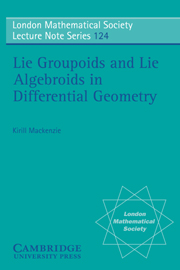Book contents
- Frontmatter
- Contents
- INTRODUCTION
- CHAPTER I The algebra of groupoids
- CHAPTER II Topological groupoids
- CHAPTER III Lie groupoids and Lie algebroids
- CHAPTER IV The cohomology of Lie algebroids
- CHAPTER V An obstruction to the Integrability of transitive Lie algebroids
- APPENDIX A On principal bundles and Atiyah sequences
- APPENDIX B On Lie groups and Lie algebras
- APPENDIX C On vector bundles
- REFERENCES
- INDEX
CHAPTER V - An obstruction to the Integrability of transitive Lie algebroids
Published online by Cambridge University Press: 03 May 2010
- Frontmatter
- Contents
- INTRODUCTION
- CHAPTER I The algebra of groupoids
- CHAPTER II Topological groupoids
- CHAPTER III Lie groupoids and Lie algebroids
- CHAPTER IV The cohomology of Lie algebroids
- CHAPTER V An obstruction to the Integrability of transitive Lie algebroids
- APPENDIX A On principal bundles and Atiyah sequences
- APPENDIX B On Lie groups and Lie algebras
- APPENDIX C On vector bundles
- REFERENCES
- INDEX
Summary
For many years the major outstanding problem in the theory of differentiable groupoids and Lie algebroids was to provide a full proof of a result announced by Pradines (1968b), that every Lie algebroid is (isomorphic to) the Lie algebroid of a differential groupoid. This problem was resolved recently in the most unexpected manner by Almeida and Molino (1985) who announced the existence of transitive Lie algebroids which are not the Lie algebroid of any Lie groupoid. (It is easily seen (III 3.16) that a differential groupoid on a connected base whose Lie algebroid is transitive must be a Lie groupoid.) The examples of Almeida and Molino (1985) arise as infinitesimal invariants attached to transversally complete foliations, and represent an entirely new insight into the subject.
We now construct a single cohomological invariant, attached to a transitive Lie algebroid on a simply-connected base, which gives a necessary and sufficient condition for integrability. The method is from Mackenzie (1980), which gave the construction of the elements here denoted eijk and the fact that if the eijk lie in a discrete subgroup of the centre of the Lie group involved, then the Lie algebroid is integrable. (In particular, a semisimple Lie algebroid on a simply-connected base is always integrable.) However in Mackenzie (1980) the author believed that sufficient work would show that the eijk could always be quotiented out.
With the discovery of counterexamples to the general result by Almeida and Molino (1985), it is easy to see that the eijk form a cocycle; it should be noted that Almeida and Molino independently made this observation for the corresponding elements in Mackenzie (1980).
- Type
- Chapter
- Information
- Lie Groupoids and Lie Algebroids in Differential Geometry , pp. 259 - 271Publisher: Cambridge University PressPrint publication year: 1987

